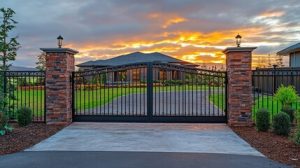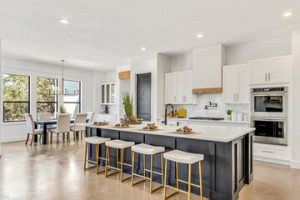Metal Privacy Gates can feel like a pause between worlds. It marks where public ends and personal begins. The first impression it gives shapes everything beyond it. A quiet line of metal can say more than words.

Metal gates carry weight that speaks without sound. Their surfaces hold the story of chosen seclusion. They stand like still sentinels at the edge of private space. Each hinge movement becomes an intentional gesture.
The choice of metal creates a subtle language of permanence. It resists the fleeting moods of weather and time. A well-kept gate seems unchanged by passing seasons. It becomes an anchor of identity for the space it guards.
Privacy through metal is not only about blocking sight. It is about guiding how curiosity flows around boundaries. What cannot be seen cannot be judged. This invisibility grants peace of mind without asking for it.
Patterns etched into metal create whispers of expression. They filter light while softening the barrier’s authority. A gate can offer hints of what lies beyond without surrendering its secrets. Art becomes part of security.
Metal privacy gates also shape movement before they even open. People slow down as they approach the barrier. That pause becomes a ritual of respect for entry. It defines personal space more deeply than walls.
The weight of metal brings a tactile finality when closed. The latch clicks with a promise of safety. That sound lingers in the mind of the person inside. It tells them they are beyond reach.
Unlike open fences, solid metal blocks shifting shadows. It creates a controlled stage of light and darkness. Within its boundaries, light behaves only as intended. Privacy becomes an art of illumination.
A metal privacy gate can influence the climate of the space it guards. It blocks wind while storing the warmth of the sun. It builds pockets of stillness where nature is hushed. Silence collects like dust along its frame.
Even the color of metal carries meaning to those who enter. Dark tones suggest quiet strength and solitude. Lighter finishes reflect openness while maintaining control. Color becomes part of the emotional script.
Some gates are built to look simple yet carry hidden depth. Behind their plainness lies meticulous craftsmanship. Their smooth lines hide the complexity of their endurance. Simplicity becomes a disguise for strength.
The aging of metal tells its own kind of truth. Tiny changes in tone hint at the years passing. Yet the structure stays unyielding, proving its patience. Time can only decorate it, never undo it.
Metal privacy gates can shape sound in subtle ways. They bounce noise outward like shields. Within their shadow, footsteps fall softer. Quiet becomes a designed experience.
Even when locked, a gate can seem like an invitation to those who understand its rhythm. It marks the threshold where trust begins. Crossing it becomes a privilege, not a right. Boundaries turn into a language of honor.
The presence of a metal gate affects behavior even unconsciously. People instinctively lower their voices near it. They walk straighter, slower, as though watched. Privacy radiates beyond its edges like a soft field.
At night, a metal privacy gate absorbs the hush of darkness. It stands almost invisible under the stars. Yet its outline guides the senses like a quiet landmark. It frames the night without interrupting it.
Metal gates reshape the space they guard by filtering human emotion. Inside, people feel sheltered from judgment. Outside, they learn to approach with care. This exchange creates an unspoken social choreography.
Even when rarely opened, a metal privacy gate is never idle. It carries the memory of every arrival and departure. Each mark on its surface is a fragment of story. Privacy becomes history etched in metal.
A closed gate can make the simplest courtyard feel like a sanctuary. It wraps silence around even the busiest surroundings. The world shrinks to only what is allowed inside. Containment becomes a kind of freedom.
Wind scraping across metal creates a low hum like distant music. This sound reminds occupants of the world beyond. Yet it stays muted, never breaking the calm. Privacy listens but does not respond.
Metal privacy gates often outlast the structures they protect. Long after walls are rebuilt, the gate endures. It becomes the soul of the place, unchanged by shifting surroundings. Continuity becomes its quiet triumph.
Even the shadows a metal gate casts have purpose. They draw lines that define safe ground. These shadows move gently as the day turns. They mark time for those within.
Metal can be shaped to conceal even the smallest gaps. It turns curiosity into reflection by showing only itself. Visitors see their own image instead of what lies beyond. Privacy becomes a mirror, not a wall.
The gate’s resistance to touch tells outsiders to pause. Its cold surface discourages casual hands. It stands to be opened only with intent. That caution preserves the boundary.
A metal privacy gate is both barrier and storyteller. It speaks of the desire to protect without isolating. It becomes the silent bridge between connection and retreat. In its stillness, it holds balance.
Even in decay, metal privacy gates hold dignity. Their worn edges suggest battles quietly won. Rust becomes a crown, not a flaw. Age does not erase their authority.
The mere act of installing a metal gate changes perception. What once felt open becomes sacred and selective. This shift redefines how space is valued. Boundaries awaken appreciation.
Metal privacy gates do not just guard property, they sculpt emotion. They turn fear into serenity by sheer presence. Their weight gives shape to trust. Trust grows in the shadow they cast.
When opened, the gate reframes the world beyond as chosen. Crossing out becomes a conscious act of leaving safety. It teaches the value of what was enclosed. Absence gains meaning.
Privacy often hides beauty until it is revealed with care. A metal gate ensures this revelation happens on your terms. It makes discovery a gift, not an accident. Control becomes kindness.
Even animals sense the aura of separation it creates. They linger outside its line and rarely cross. Its structure radiates ownership without aggression. Nature respects what stands so still.
Metal privacy gates redefine the meaning of arrival. They make entry feel ceremonial instead of casual. Passing through becomes a moment worth noticing. Presence becomes deliberate.

